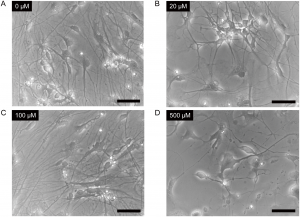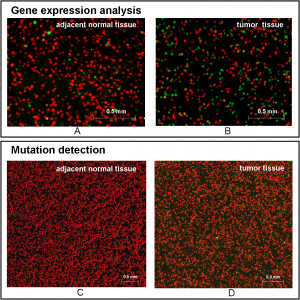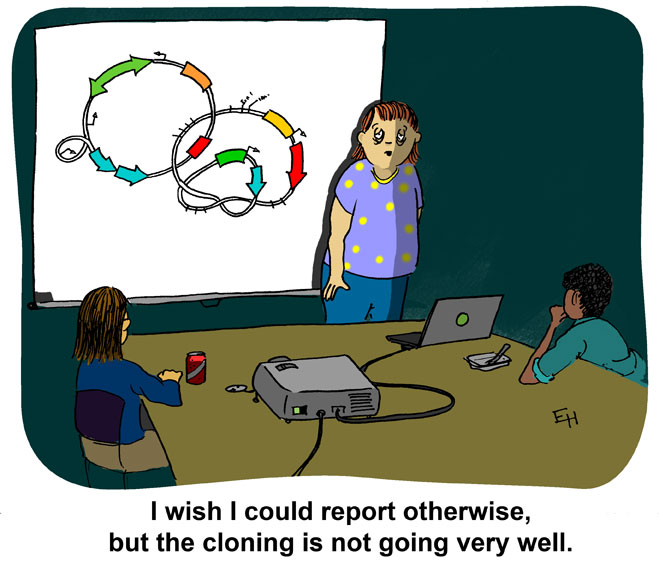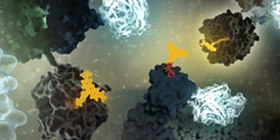
Cells were treated with 0μM (Panel A), 20μM (Panel B), 100μM (Panel C) or 500μM (Panel D) ketamine for 24 hours. Scale bar = 50μm. From Ito, H., Uchida, T. and Makita, K. (2015) Ketamine causes mitochondrial dysfunction in human induced pluripotent stem cell-derived neurons. PLOS ONE 10, e0128445.
doi:10.1371/journal.pone.0128445.g002
Author: Sara Klink
Cancer Detection on a Chip?

Cloning Tips for Restriction Enzyme-Digested Vectors and Inserts

Could This be the Next Generation Ebola Virus Vaccine?
Ebola virus has received a lot of press in the last year due to the extended epidemic outbreak in Africa. Ebola is part of the family of Filioviruses (filamentous virus) and causes hemorrhagic fever that leads to internal bleeding and loss of bodily fluids. As the epidemic in Africa has illustrated so starkly, once the virus infects a large enough population, the human suffering it causes is devastating to individuals and communities. Because no treatment other than palliative fluid support is available to those infected by Ebola virus, virologists have focused attention on potential therapeutics and vaccines. The vaccine strategies now in clinical trials are based on a single Ebola virus glycoprotein, GP, and involve a DNA-based vaccine or innoculation with an Ebola protein expressed from a viral vector. How effective and safe this approach may be for protection from Ebola virus infection is currently under investigation.
Based on the history of effective vaccines, Marzi et al. was interested in testing a whole-virus vaccine for Ebola (EBOV). A whole-virus-based vaccine like smallpox or measles uses an attenuated or inactivated virus. The advantage of this method is that all the proteins as well as the nucleic acid are available for immunological reaction, offering broader-based protection than a single protein. In the recently published Science report from Marzi et al., a replication-incompetent Ebola virus was used as the basis for a whole-virus vaccine that was tested for its efficacy in nonhuman primates.
Continue reading “Could This be the Next Generation Ebola Virus Vaccine?”Uncovering Protein Autoinhibition Using NanoBRET™ Technology

In a study published in Proceedings of the National Academy of Sciences USA article, Wang et al. used the principle of the Promega NanoBRET™ assay to understand how ERK1/2 phosphorylation of Rabin8, a guanine nucleotide exchange factor, influenced its configuration and subsequent activation of Rab8, a protein that regulates exocytosis.

Rab8 is a member of the Rab family of small GTPases and an important regulator of membrane trafficking from the trans Golgi network and recycling endosomes to the plasma membrane. Wang et al. were interested in learning how the guanine nucleotide exchange factor (GEF) Rabin8, a known activator of Rab8, was itself activated to better understand how Rab8 and exocytosis were regulated in the cell. First, they confirmed if the consensus extracellular-signal-regulated kinases ERK1/2 phosphorylation motif uncovered in Rabin8 resulted in phosphorylation of Rabin8. Both in vitro analysis and cell-based assays confirmed that ERK1/2 phosphorylated Rabin8. Next, the GEF activity of Rabin8 was assessed to determine if ERK1/2 phosphorylation activated the GEF. Researchers confirmed activation of Rabin8 GEF in vitro.
Continue reading “Uncovering Protein Autoinhibition Using NanoBRET™ Technology”Tracking the Beginning of a Pathogenic Bacterial Infection

General Considerations for Transfection
 Many studies, from reporter assays to protein localization to BRET and FRET, require successful transfection first. Yet, transfection can be tricky and difficult. There are many considerations when planning transfection of your cells including reagent selection, stable or transient experiment, type of molecule and endpoint assay used. Here we discuss these considerations to help you plan a successful transfection scheme for your experimental system. Continue reading “General Considerations for Transfection”
Many studies, from reporter assays to protein localization to BRET and FRET, require successful transfection first. Yet, transfection can be tricky and difficult. There are many considerations when planning transfection of your cells including reagent selection, stable or transient experiment, type of molecule and endpoint assay used. Here we discuss these considerations to help you plan a successful transfection scheme for your experimental system. Continue reading “General Considerations for Transfection”
Using Laser Treatment to Eliminate Blood-Borne Pathogens
The authors used ultrashort pulsed (USP) lasers in their research as this treatment is known to inactivate a spectrum of bacteria and viruses including nonenveloped viruses, a class of virus that resists inactivation. Furthermore, the laser treatment is nonionizing and does not modify proteins covalently, meaning that proteins present in blood are likely to remain active even after exposure to USP lasers. The viruses that were tested for inactivation by USP laser in human plasma were an enveloped RNA virus human immunodeficiency virus (HIV), nonenveloped RNA virus hepatitis A virus (HAV) and enveloped DNA virus murine cytomegalovirus (MCMV). Continue reading “Using Laser Treatment to Eliminate Blood-Borne Pathogens”
DNA Amplification Using Body Heat, No Instrument Required

Improving Cancer Drug Screening with 3D Cell Culture

